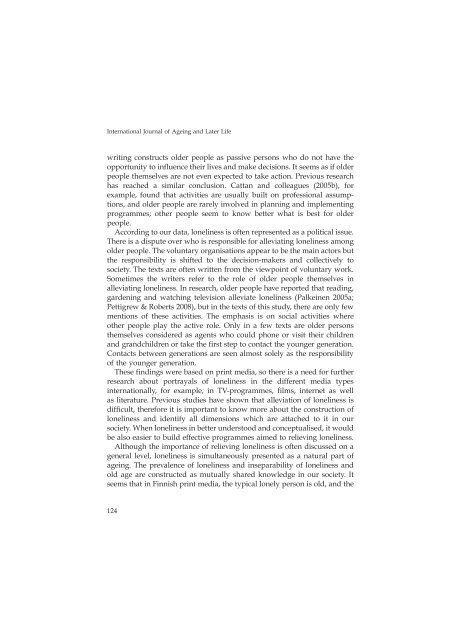Avaa tiedosto - TamPub - Tampereen yliopisto
Avaa tiedosto - TamPub - Tampereen yliopisto
Avaa tiedosto - TamPub - Tampereen yliopisto
You also want an ePaper? Increase the reach of your titles
YUMPU automatically turns print PDFs into web optimized ePapers that Google loves.
International Journal of Ageing and Later Life<br />
writing constructs older people as passive persons who do not have the<br />
opportunity to influence their lives and make decisions. It seems as if older<br />
people themselves are not even expected to take action. Previous research<br />
has reached a similar conclusion. Cattan and colleagues (2005b), for<br />
example, found that activities are usually built on professional assumptions,<br />
and older people are rarely involved in planning and implementing<br />
programmes; other people seem to know better what is best for older<br />
people.<br />
According to our data, loneliness is often represented as a political issue.<br />
There is a dispute over who is responsible for alleviating loneliness among<br />
older people. The voluntary organisations appear to be the main actors but<br />
the responsibility is shifted to the decision-makers and collectively to<br />
society. The texts are often written from the viewpoint of voluntary work.<br />
Sometimes the writers refer to the role of older people themselves in<br />
alleviating loneliness. In research, older people have reported that reading,<br />
gardening and watching television alleviate loneliness (Palkeinen 2005a;<br />
Pettigrew & Roberts 2008), but in the texts of this study, there are only few<br />
mentions of these activities. The emphasis is on social activities where<br />
other people play the active role. Only in a few texts are older persons<br />
themselves considered as agents who could phone or visit their children<br />
and grandchildren or take the first step to contact the younger generation.<br />
Contacts between generations are seen almost solely as the responsibility<br />
of the younger generation.<br />
These findings were based on print media, so there is a need for further<br />
research about portrayals of loneliness in the different media types<br />
internationally, for example, in TV-programmes, films, internet as well<br />
as literature. Previous studies have shown that alleviation of loneliness is<br />
difficult, therefore it is important to know more about the construction of<br />
loneliness and identify all dimensions which are attached to it in our<br />
society. When loneliness in better understood and conceptualised, it would<br />
be also easier to build effective programmes aimed to relieving loneliness.<br />
Although the importance of relieving loneliness is often discussed on a<br />
general level, loneliness is simultaneously presented as a natural part of<br />
ageing. The prevalence of loneliness and inseparability of loneliness and<br />
old age are constructed as mutually shared knowledge in our society. It<br />
seems that in Finnish print media, the typical lonely person is old, and the<br />
124














